SWEDISH SOUTH ASIAN STUDIES NETWORK
Danish Tranquebar projects part of Galathea 3 expedition
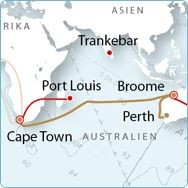 150
years after the first Danish maritime research expedition to the
Far East, the so called Galathea
1 expedition (1845-47), Danish researchers
in many fields are now again participating in a similar round-the-world
expedition, Galathea 3, that rougly follows the same sea route
as its predecessor in the 1840s and the much publicised Galathea
2 expedition, carried out during the
years 1950-52.
150
years after the first Danish maritime research expedition to the
Far East, the so called Galathea
1 expedition (1845-47), Danish researchers
in many fields are now again participating in a similar round-the-world
expedition, Galathea 3, that rougly follows the same sea route
as its predecessor in the 1840s and the much publicised Galathea
2 expedition, carried out during the
years 1950-52.
On Friday 11 August 2006, the 3rd Galathea Expediton
was en route (after more than six years of intensive planning),
when the expedition ship VÆDDEREN,
an offshore patrol frigate temporary refitted as an expeditionary
vessel, departed Copenhagen harbour. The course initially
took the ship to the North Atlantic, with stops in the Faeroe Islands
and Greenland. Then the route turned south along the west coast
of Afrika with a stop-over in Ghana, to Cape Town (photo below
from the arrival to Cape Town on 15 October 2006).
From South Africa
the ship now travels eastwards across the Indian Ocean to Australia,
Solomon Islands and New Zeeland, before crossing also the Pacific
Ocean with the destination Chile. See
map of the route for Galathea 3.
The expedition then continues
northwards along the west coast of South America to the Galapagos
Islands, through the Panama Canal to the Caribbean and the US,
and concludes its circumnavigation of the globe with a voyage across
the Atlantic, whereupon it will arrive back in Copenhagen ultimo
April 2007.
Strengthening Danish research
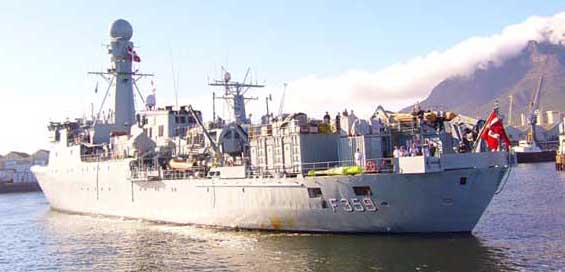 The idea of sending out a third Galathea expedition
was put forward from several quarters in Denmark, not least when
the new millennium, and thus the 50th anniversary of the departure
of the second Galathea expedition, was approaching. However, it
was the newspaper Morgenavisen Jyllands-Posten that picked up the
baton and developed the idea into the concept that has since developed
into a broad national event and a poster project for Danish research.
The idea of sending out a third Galathea expedition
was put forward from several quarters in Denmark, not least when
the new millennium, and thus the 50th anniversary of the departure
of the second Galathea expedition, was approaching. However, it
was the newspaper Morgenavisen Jyllands-Posten that picked up the
baton and developed the idea into the concept that has since developed
into a broad national event and a poster project for Danish research.
The aim of Galathea 3 is to strengthen Danish research, not only
by virtue of the implementation of specific research projects onboard,
but also in relation to the international research network of which
Denmark is a part. At the same time, Galathea 3 is intended to
provide a boost for the recruitment of new scientists in the future.
The ship is fully equipped with modern communication systems enabling
it to transmit news of natural sciense direct to clasrooms back
in Denmark, as well as a number of students will be on board to
make their own studies. Galathea
3 Expedition web page.
The Galathea 3 expedition has been planned and implemented
by the so-called Danish Expedition Foundation, a commercially
operating foundation established by the Ministry of Science, Technology
and Innovation. The Danish Expedition Foundation has at the
same time been entrusted with the task of raising funds to secure
the financing of the project, partly through government grants
and partly through donations from private foundations and enterprises.
The Danish Expedition Foundation bears the same name as the foundation
behind Galathea 2 (1950-52) and a number of other expeditions.
On
behalf of the Danish Expedition Foundation’s
board of trustees, the Danish Research Agency (since 1 May 2006
part of the Danish
Agency for Science, Technology and Innovation)
in 2004 invited proposals and ideas for destinations and projects
to be included in the Galathea 3 expedition. The
invitation was implemented as a public preliminary survey, for
which scientists and research institutions were invited to submit
proposals for destinations and possible projects to be included
in the expedition.
On 29 November 2005, the Danish
Expedition Foundation issued an announcement of the total of 71
projects that had been selected to participate in the expedition,
several of them connected to the Indian Ocean, the Nicobar Islands
and Tranquebar in India.
Strong connection to Nicobar Islands, Tranquebar and Serampore
When Galathea 1 (1845-47) departed from Copenhagen
on 14 May 1845, the Royal Danish Academy of Sciences and Letters
had received a letter from King Christian VIII, who was known for,
among other things, his great interest in natural history. This
was the beginning of the first Galatea expedition. The letter included,
among others, the following passage: "We
have decided to send the Corvette Galathea to the East Indian Islands
and particularly the Nicobar Islands, over which We hold Sovereignty,
in order to perform scientific Survey of the natural Products of
this Group of Islands and their use for Cultivation and Trade."
In
his instructions, the king furthermore requested the academy to
appoint "persons learned in the study of Nature and aides
to assist them". The purpose of the expedition was, besides
the exploration of the Nicobar Islands, to hand over the Danish
colonies of Tranquebar in South India and Frederiksnagore (present-day
Serampore) in Bengal to the British East India Company, the expansion
of the trade with China, and negotiation and conclusion of new
trading contracts.
The second
Galathea
expedition (1950-52)
visited several
of the destinations that also Galathea 1 had visited more than
100 years earlier. One of these destinations was again the not
particularly well-known former Danish colony, the Nicobar Island
in the Bay of Bengal. The research scientists on Galathea 2 followed
up on the findings from the first Galathea expedition in order
to document the development over the intervening period.
The 2006-07 Galathea
3 expedition will not make any stop-overs in India, not even in
the Nicobar Islands – extremely hit by the tsunami disaster in
2004. Researchers on board will however make several scientific
studies related to the Indian Ocean. For example, Dr. Torkel
Gissel Nielsen from the Dept. of Marine Ecology, National
Environmental Research Institute in Roskilde, will do a study
of ”Plankton dynamics in the Andaman Sea”, funded by the Danish
Research Council for Nature and Universe.
Tranquebar Initiative of the National Museum of Denmark
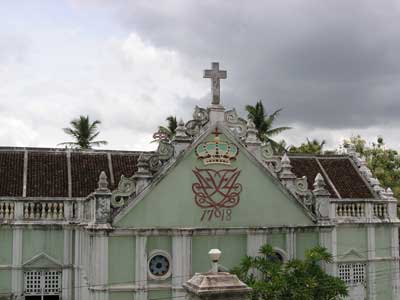 Still around 20 research projects connected to Tranquebar
will be carried out within the framework of the Galathea 3 expedition,
and also a couple of projects dealing with the Nicobar Islands
and Serampore (Frederiksnagore).
Still around 20 research projects connected to Tranquebar
will be carried out within the framework of the Galathea 3 expedition,
and also a couple of projects dealing with the Nicobar Islands
and Serampore (Frederiksnagore).
The
Tranquebar Initiative of the National Museum of Denmark, with
several projects in different fields is coordinated by the National
Museum of Denmark. The museum has rich collections from the 1845
expedition, when the corvette Galathea visited the then Danish
colony of Tranquebar (in present-day Tamil Nadu). On that occasion
Captain Steen Bille at an official ceremony lowered the Danish
flag Dannebrog from the flagpole of the Fort Dansborg, since the
visit took place in connection with the transfer of the Danish
colonial properties in India to England. During the visit, the
expedition members travelled inland, registering daily life in
the villages on the former Danish territory and collecting objects
for The Ethnographical Museum in Copenhagen, which is now a part
of the National Museum of Denmark.
On the modern Galathea3,
the Tranquebar projects have been given a land-based platform,
from where they will transmit to the ship about various forms of
activities. The goal of the Tranquebar Initiative is to strengthen
the ongoing Indo-Danish efforts to preserve the intercultural heritage
and to explore the colonial Indo-Danish cultural encounters. Also
restoration of building structures from the Danish period (1620-1845)
is taking place as well as investigations related to the social
and cultural processes of transformation taking place in modern
Tranquebar within almost all sectors. The Tranquebar Initiative
of the National Museum of Denmark is an interdisciplinary endeavour
and prepared in close collaboration with a number of Indian authorities
and Indian and Danish research institutions. The Initiative ranges
from various research projects to restorations of buildings from
the colonial time and the collecting of ethnographical items to
elucidate present daily life, as well as historical and ethnographical
exhibit activities in Denmark and India. The plan is in the various
projects to involve a number of PhD-projects and also master students
and trainees from both Denmark and India.
The following projects are part of the 2006-07 Tranquebar Initiative:
• Children in an Imperial Encounter. Pre-doc project by Karen Vallgårda, Tamil Studies at Colombia University and The New School for Social Research, New York. The topic is childhood in the cultural encounter between Indians and Danes in South India 1862-1919. In that period, the majority of Danes who traveled to India were Christian missionaries and they came into contact primarily with so-called “low-caste” Indians. It is often neglected, however, that children also took part in the encounter. Indian children attended missionary schools, were adopted by Danes or worked in their households. Danish children came to India with their parents or were born in India. Finally, a small number of mixed-descent children resulted from sexual relations between Danes and Indians. The aim of the project is to investigate how Danish and Tamil adults reflected and acted in relation to children and childhood, as well as how the different groups of children experienced the encounter. More information about the project.
• Daily life on Fort Dansborg in colonial times: Archaeological investigations based on trial ditches in and around Fort Dansborg. Project by Niels Engberg and John Simonsen. Fort Dansborg presents a unique opportunity to seek to enlighten interesting aspects of daily life in and around the Dansborg Fort in the early days of the Indo-Danish cultural encounter in Tranquebar. Archaeological finds can throw light on the key questions on the cultural encounter. In other words, do finds from daily life reflect an Indo-Danish cultural encounter and if so, which characters do the finds have? How were Indian and European artefacts, commodities, food, and other items integrated in daily life? More information about the project.
Danish Colonialism in India: The Encounter with Indian Society and Culture 1620-1845. Project by Associate Professor Esther Fihl, Centre for Comparative Cultural Studies, Department of Cross-Cultural and Regional Studies, University of Copenhagen. The Danish colony Tranquebar was established in 1620 on the southern Coromandel Coast in India as headquarter for the Danish expansion in Asia, parallel to and following the examples of especially the Dutch and English merchants. During the following 225 years, the Danes built up a colonial town whose special lay-out and historical buildings are still found in Tranquebar today. The present historical-anthropological research project will focus on the life which took place in and around these buildings and which in many ways can be characterized as an Indo-Danish cultural encounter. More information about the project.
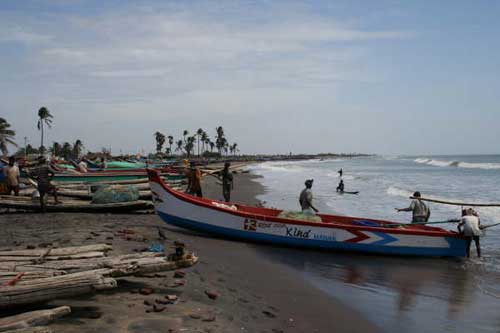
• The Fishermen Community in Tranquebar: Anthropological investigations of socio-economic living conditions 1980-2010. Another project by Associate Professor Esther Fihl. Like in colonial times, the village of Tranquebar today consists of different quarters, each inhabited by a certain jati or socio-religious group. The largest of these neighbourhoods is still the fishermen part of the village situated to the north - and some of it on top of the Old Danish fortification wall around Tranquebar. On the basis of my earlier data from this community, this research project will try to document both the long and the short term socio-economic transformation processes in the fisherman’s ways of dealing with everyday life and its problems. An increasing number of especially young unmarried men have during the last 25 years left the fishing community in Tranquebar for a couple of years to go to Malaysia, Singapore or Saudi-Arabia in order to find work, primarily low-paid jobs in the building industry. From abroad, these young men often functioned as breadwinners for their families, besides saving money to buy boats upon their return to Tranquebar. The question is, if the tsunami catastrophe has meant that more fishermen now than before seek new livelihoods elsewhere? Has there been an intensification of transnational migration and have new ways of handling economic affairs and crisis emerged? More information about the project.
• The Tsunami in Tranquebar: The fishing community’s way from collapse to reconstruction. Project by Esther Fihl and Research Assistant Frida Hastrup, Centre for Comparative Cultural Studies, Department of Cross-Cultural and Regional Studies, University of Copenhagen. More information about the project (in Danish only).
• The Tsunami in Tranquebar – Social Reconstruction and Notions of Risk in a post-tsunami society. Ph.D. project by Frida Hastrup, Centre for Comparative Cultural Studies, Department of Cross-Cultural and Regional Studies, University of Copenhagen. In December 2004, the tsunami in the Indian Ocean caused severe damages to Tranquebar, killing around 800 people, destroying houses, boats and agricultural land, and leaving high demands for relief aid in the area. The aim of this Ph.D.-project is to analyse the social and cultural effects of the tsunami in Tranquebar and the attendant process of reconstruction. The project focuses on the ways in which the social life in Tranquebar (family structures, power relations, education etc.) has been affected, and investigates how changing notions of risk and safety become implicit factors in the process of reconstruction. More information about the project
• The Indo-Danish Cultural Encounter with Special Reference to Print in the Eigteenth Century. Project by Dr. A. R. Venkatachalapathy, Madras Institute of Development Studies, Chennai, India. The Tamil language is not only the first Indian language but also the first non-European language to see print. While the first Tamil books were printed on the West Coast by the Portuguese the real story of print in India with significant social and cultural impact begins with the setting up of the printing press in Tranquebar by the Lutheran missionaries in the first decade of the eighteenth century. More information about the project.
• The Colonial School Tradition in Tranquebar. Project by Dr. Keld Grinder-Hansen, Director of The Danish School Museum. A remarkable concentration of educational institutions exists in present-day Tranquebar. This reflects a strong educational tradition in the area, which can be traced directly to the arrival of the Danish Lutheran Halle-Mission in 1706. Some decades later a rival Lutheran mission – the Moravian Brethren – arrived at Tranquebar, where they established a mission station outside the town perimeter. Contrary to their success in other Danish colonies (eg. Greenland and the Danish West Indies) the Moravian Brethen did not succeed in getting a firm grip of the Lutheran mission in Tranquebar, and had to see themselves beaten by the Danish-Halle Mission. The descendants of the Danish-Halle Mission – the Tamil Evangelical Lutheran Church (TELC) still holds a strong position in the educational system of modern Tranquebar and is responsible for primary and secondary schools, along with a teacher training college in the town. More information about the project.
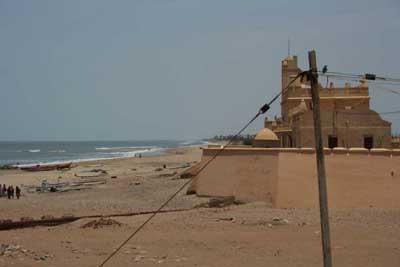
• The History of Tranquebar before, during and after Danish rule – an educational project. Dr. Keld Grinder-Hansen, Danish School Museum. An educational exhibition will be established at Dansborg, describing the history of the Tranquebar area before, during and after the Danish period. The aim of this project is to: Establish an exhibition, which will provide local schools with a possibility of using the local history including the preserved historical monuments in their teaching, in a more qualified way. Produce educational programmes and materials published in English, Tamil and Danish to complement the exhibition. Formal training programme for local guides to enable professional guiding of visiting schools and other groups through the exhibition at Dansborg. More information about the project
• Food and cultural heritage. Diffusion and innovation studies of the Danish food tradition in Tranquebar. Project by Sabine Karg, The National Museum of Denmark The project is part of Galathea3 and financed by the Bikuben Foundation The project deals with the interactions between the indigenous cuisine and the new foodstuffs and dishes introduced by the Danish colonists. Food represents an essential part of our daily life and the history of foodstuffs is a central element of our cultural heritage. In Tranquebar, one of the most important economical aspect was set in the trade with spices. In the present project we want to enlighten the interplay between the colonists and the local residents concerning their food traditions and their treatment with the newly introduced food. How were the new foodstuffs – the Danish and the foreign ones – accepted and later integrated into the traditional cuisine? When and how quick did the newly imported spices find their way into the Danish kitchen? More information about the project.
• The Low Castes of Tranquebar: Museum Collecting with special focus on culture, religion and everyday life of the low castes and religious minorities. Project leader: Bente Wolff, Curator at the National Museum of Denmark, Ethnographic Collection. Project participant: Caroline Lillelund, Research assistant, student of the Institute of Anthropology, University of Copenhagen. When the Danish merchants and colonial officials came to Tranquebar, they encountered a cultural, religious, and economical diversity unlike that of even the most composed European societies. Wealthy princes with grand palaces, ascetic hermit priests, snake charmers, fishermen, basket makers and isolated “primitive” tribes were all integrated into a social system of numerous castes and religious groups with mutual rights and obligations. This multiplicity of cultures and communities both fascinated and astonished the newly arrived Danes. More information about the project.
• The first Danish-Indian relations. Project by Tine S. Jensen about the first Danish visitors to India in the 1620s. More information about the project (in Danish only).
• The Peter Anker collection at the Danish National Museum: A joint Indo-Danish project. The aim of this project is to invite an Indian specialist on South Indian temple bronzes to Denmark to produce an annotated catalogue of the collection of 24 temple bronzes found and excavated in Tranquebar in 1799. The historic-stylistic analysis of the Indian guest researcher will be supplemented by archaeometric analysis carried out by a Danish specialist from the School of Conservation or the National Museum. The Collection consists of 14 figures and 10 pieces of temple equipment. In 1808 the Norwegian governor to Denmark, Peter Anker, brought the bronzes to Norway, from where they were purchased in 1843 for the Ethnographic Collection of what later became the National Museum of Denmark. The name of the Indian specialist who will undertake this project is not yet available, but will be publicised as soon as negotiations have been concluded. Applications regarding this project kan be directed to Bente.Wolff@natmus.dk. More information.
• Restoring the historic buildings and studying their prior use. Project responsible Kjeld Borch Vesth, curator, The National Museum of Denmark. During the 225 years Tranquebar functioned as a Danish colony, a number of stone buildings were erected – some of which still exist. Several are threatened by subversion due to the failing of maintenance, caused by lack of financial resources locally and other domains been prioritised by the regional antiquarian authorities. Within the last couple of decades a renewed Danish interest has taken place in the area and efforts have been done to form the baseline of initiatives to save the buildings from demolishing. Within the last years the primary mover in Tranquebar has been the Trankebar Association (Foreningen Trankebar) that initiated and partly implemented (in collaboration with the Indian architect Chella Pillai) the restoration of the first third of Fort Dansborg, while the Indian authorities restored the remaining two thirds of Dansborg. The Association has now continued its efforts with a renovation of the Nygade cemetery. More information about the project
• Traditional South Indian Medicine Surrounding Tranquebar. Project by Dr. Kenneth G. Zysk, Institute for Cross-Cultural and Regional Studies, Department of Asian Studies, University of Copenhagen. This project focuses on the history and development of Siddha medicine in Tamil Nadu and its relationship to Ayurveda Before the coming of the Muslims in the tenth century A.D., two predominant forms of medicine existed in India: Ayurveda in the north, central, and parts of Kerala in the south, and Siddha principally in Tamilnadu. Both have long histories and are still practised in their respective regions of India. Much has been written about the history, development, and practice of Ayurveda in Sanskrit and Hindi. Comparatively less is known about Siddha because its literary history is meagre, and knowledge of Siddha has been passed down via oral tradition from teacher to student. More information about the project
• Tranquebar – Whose History? Transcultural Heritage in a Former Danish Trading Colony in India. Ph.D. project by Helle Jørgensen. Tranquebar is currently under development as a Heritage Area. Local authorities in Tranquebar and Tamil Nadu aim to develop the area as a destination for heritage tourism. An important background for this process is to be found in Tranquebar’s joint Indo-Danish history as a trading colony in the years 1620-1845. The historical traces of this period are clearly visible today, as Tranquebar remains the most well preserved former European trading colony on the Indian coast. Within recent years, a number of the historical buildings in Tranquebar have been restored on the initiative both of Danish and Indian NGOs, authorities and private interests. The material remains from the Indo-Danish colonial period have thus attracted wide contemporary interest, and Tranquebar is highlighted as an expression of heritage. But what is actually conceptualised as heritage in this intercultural context, and whose heritage is being protected by the restoration of the buildings from the Indo-Danish colonial period? More information about the project

• Tranquebar in Danish Literature. A Project by Associate Professor Kirsten Thisted, Institute of Cross Cultural and Regional Studies, Department of Minority Studies, University of Copenhagen. The project will study Danish representations of Tranquebar from a narratological point of view. This study is part of a larger project, comparing Danish representations of the Arctic with Danish representations of the Tropics. What type of narratives does Tranquebar call forth? How is the relation between the representations in literary narratives (prose fiction, poems, childrens books etc.), historical sources (missionaries’ diaries, contemporary accounts etc.) and later historiography/schoolbooks? More information about the project
• Faith, Caste and Social Capital – what happened to the Christian Churches in Tranquebar after India’s Independence. Project by Dr. Peter B. Andersen, University of Copenhagen, Dr. Stig Toft Madsen, Nordic Institute for Asian Studies, Copenhagen, and Dr. Oluf Schönbeck, University of Copenhagen. More information about the project (in Danish only).
• Protection of Tranquebar Heritage and the Creation of Employment Opportunities through Planned Sustainable Tourism Development. Project carried out by Nils Finn Munch-Petersen, MSc in ethnography, tourism planner and specialist in nature- and culture tourism who has worked in India numerous times. Tranquebar is the best preserved, and the least altered, of the former European trading posts on the Indian coast. A meeting ground for Indian and Danish culture. The grid of straight streets, the Gate, the Dansborg Fortress, beautifully placed overlooking the long coastal beach; the Danish churches and cemeteries, the Parade Ground, and a serene and quiet town with a minimum of vehicular traffic, giving the best possible options for developing cultural- and beach tourism. It is accordingly important, right now when India experiences fast economic growth, to ensure that tourism development will preserve the culture of Tranquebar, as to buildings, streets and the composition of population groups. More information about the project.
• Tranquebarian Connections: Science, Medicine and Scientific Networks in the Danish East Indies, c. 1770-1845. Project by Niklas Thode Jensen, The Saxo-Institute, University of Copenhagen. In literature on Danish history the Danish East Indies has traditionally been associated with trade and maritime commerce, especially the fortified colonial town of Tranquebar. This image is not incorrect; yet it is very simplified and one-sided. Many other surprising activities went on in the apparently provincial town of Tranquebar. In the period c. 1770-1845 Tranquebar was the centre of a number of scientific activities in areas such as botany, astronomy, medicine, religious and linguistic sciences. The most important scientific activity, however, was the constant communication and discussion of new knowledge through an extensive scientific network of people and organisations both in India, Europe and Denmark. More information about the project
Frederiksnagore and The Nicobar Islands
• Sulphur and Saltpetre for the production of gunpowder. Project by Peter Vemming Hansen, Middelaldercentret, Nyköbing Falster, dealing with the production of gunpowder, that was dependent on access to saltpetre. This can be found natural only in few places outside China, in India it is found in Bengal, a province that came to be known as the reservoire of salpetre in the World. More information about the project (only in Danish).
• Culture and Catastrophe: An analysis of risk administration in the Nicobars after the tsunami. Dr. Kåre Jansbøl, Institute for Anthropology, University of Copenhagen. Project dealing with how the Nicobarese handled risks in connection with the tsunami that killed almost a third of the population in the islands. It focuses on the interaction between state and commercial administration and the local population. More information about the project (only in Danish).
SASNET - Swedish South Asian
Studies Network/Lund University
Address: Scheelevägen 15 D, SE-223 70 Lund, Sweden
Phone: +46 46 222 73 40
Webmaster: Lars Eklund
Last updated
2006-12-14
